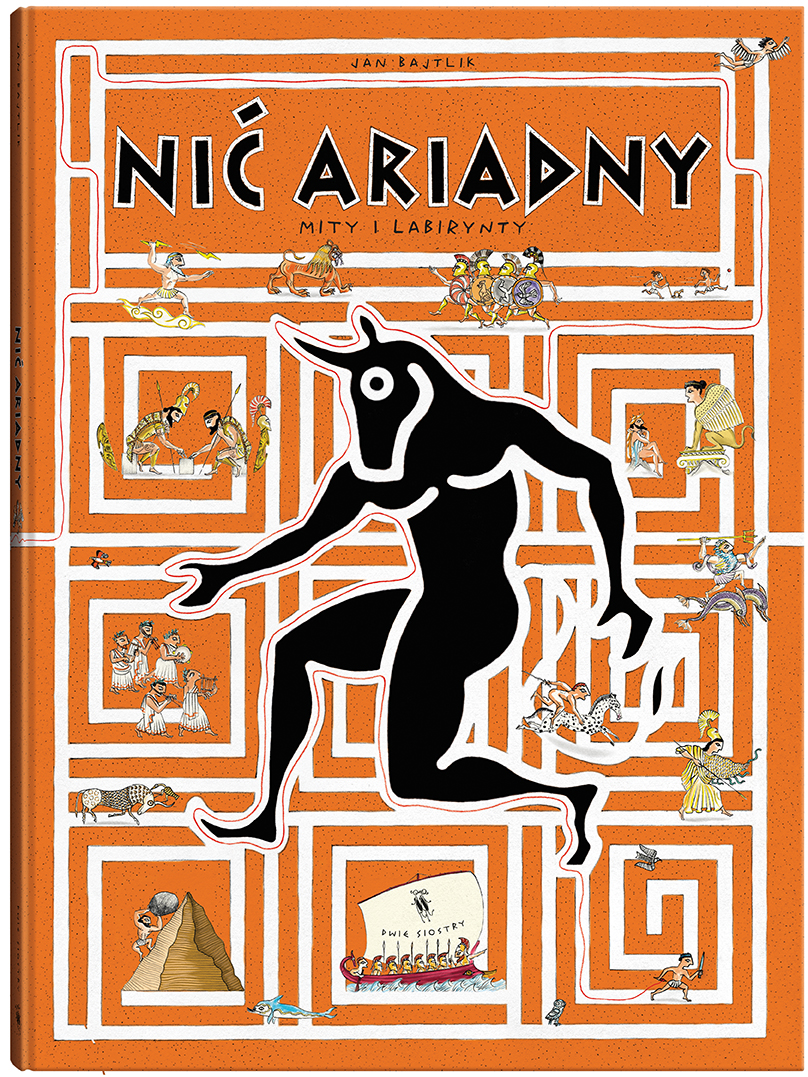Title of the work
Country of the First Edition
Country/countries of popularity
Original Language
First Edition Date
First Edition Details
Jan Bajtlik, Nić Ariadny. Mity i Labirynty [Ariadne’s Thread: Myths and Labyrinths]. Warsaw: Wydawnictwo Dwie Siostry, 2018, 72 pp.
ISBN
Genre
Nonfiction novels
Picture books
Wimmelbook*
Target Audience
Children (7+ (according to the publisher) )
Cover

Courtesy of the publisher.
Author of the Entry:
Anna Mik, University of Warsaw, anna.m.mik@gmail.com
Peer-reviewer of the Entry:
Elżbieta Olechowska, University of Warsaw, elzbieta.olechowska@gmail.com
Susan Deacy, University of Roehampton, s.deacy@roehampton.ac.uk

Jan Bajtlik
, b. 1989
(Author, Illustrator)
Jan Bajtlik is one of the best known Polish illustrators. He graduated from the Academy of Fine Arts in Warsaw. Besides illustrating children’s books, he designed clothes patterns for Hermès, numerous posters, magazine covers and created graphics for advertisements. Bajtlik’s non-fiction book Alphadoodler won Bologna Ragazzi Award in 2015.
Source:
bajtlik.eu (accessed: July 19, 2019)
Bio prepared by Anna Mik, University of Warsaw, anna.m.mik@gmail.com
Summary
Bajtlik’s mythical catalogue consist of numerous depictions of the labyrinth in various configurations, each alluding to classical motifs and mythological stories. In the Introduction we read that ancient Greece was one of the most fascinating countries in the world whose culture and history influenced Europe and are admired to this day (Bajtlik, 2018: 5). Labyrinths drawn and described by Batjlik ought to lead the reader through this tradition, and teach them about ancient stories and customs. There is also an instruction how to use the book: find the only way out of each labyrinth, get to know Greek mythology in all details hidden on the pictures, and find explanatory glossary at the end of the book (assigned to each labyrinth).
On the next pages readers have the possibility to – literally – read the labyrinths: from the war between titans and gods, to various myths concerning, inter alia, Prometheus, Heracles, Minotaur, Trojan War and Odysseus’s adventures – all the way through to ancient Greek history and customs. The last labyrinth represents ancient theatre, where viewers enjoy the spectacle, as supposedly readers are enjoying the book. On each page every single detail and phrase have a meaning – if not explained right away, this is, possibly, found at the end of the book.
At the end, as promised, the reader can find several pages with text alluding to each labyrinth, containing more detailed description of each story or phenomenon. As a whole, Ariadne’s Thread is a collection of myths, designed for children as implied readers – but perfectly suitable also for an older audience.
Analysis
The book is a postmodern variation of classical mythology and ancient tradition. Its labyrinths more accurately correspond to the concept of modern culture: complicated, variated, full of possibilities of interpretation. Jan Bajtlik, being both writer and illustrator, presents a coherent text, nevertheless full of entrances and misleading turns. At the same time, he gives the reader a tool to get through the labyrinth (which is the book itself): Ariadne’s Thread, the glossary with clarifications, concerning each story/labyrinth. This strategy may allude to the ancient belief that in the center of a labyrinth awaits not a scary monster, but knowledge, that everyone should peruse. In this case, the knowledge would be the glossary at the end of the book that the reader might find after going through the maze.
It is also interesting that exploration of Greek Myth – Minotaur’s maze – is focused not on an evil monster waiting in its centre, but on woman’s tool vital in survival – Ariadne’s thread, a symbol of wisdom. In this non-fiction book the author points to the fact that in Greek mythology not a single story is simple, there is no one version of a myth, and a lot depends on readers’ interpretation. Bajtlik, on one hand, gives such a possibility by letting a child into a maze of each story, on the other – he seems to attempt organizing gained knowledge by adding the glossary. It also seems vital that his illustrations correspond to the text flawlessly, as he is the author of both. As a non-fiction book is informative, at the same time, it poses to be a traditional Wimmel-buch, with multiple doodles and drawings, that imitates chaos that contains a cosmic order of Greek mythology.
Further Reading
Cianciolo, Patricia J., Informational Picture Books for Children, Chicago: American Library Association, 2000.
Kurwinkel, Tobias, Bilderbuchanalyse: Narrativik – Ästhetik – Didaktik, Tübingen: UTB, 2017.
Sanders, Joe Sutliff, A Literature of Questions: Non-fiction for the Critical Child, Minneapolis, MN: University Minnesota Press, 2018.


